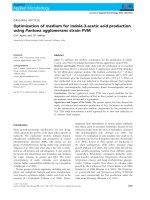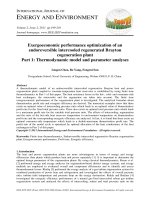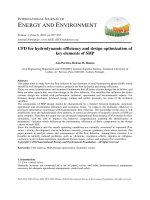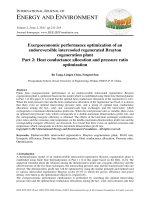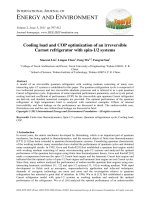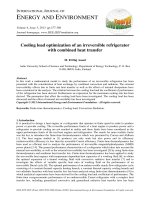Optimization of PCR
Bạn đang xem bản rút gọn của tài liệu. Xem và tải ngay bản đầy đủ của tài liệu tại đây (315.43 KB, 22 trang )
Optimization of PCR
4.1 Introduction
Depending on the success of your PCR amplification it may be necessary
to optimize the conditions. This Chapter deals with various aspects of PCR
optimization including reagents, temperatures, enhancers and preventing
contamination. There is also a troubleshooting guide that will hopefully
help you identify the source of any problems.
Control reactions
It is important to perform control reactions in parallel with the test samples
to indicate whether any specificity (Section 4.2) or contamination (Section
4.5) problems exist. At least two controls are essential, a reaction contain-
ing no DNA and one containing no primers. You should think of the
control reactions as being just as important as your test samples and there
are times when you may wish to include more controls. For example, if you
are beginning to work with a new pair of primers, it is a good idea to include
controls containing single primers. In this way you can see whether any
products are generated from either of the primers alone, rather than by the
two working in combination.
4.2 Improving specificity of PCR
Primer pairs do not all work under the same reaction conditions. In some
cases under ‘standard’ conditions one pair of primers will work very
efficiently and give rise to a unique product in large amounts. At the same
time, and under identical reaction conditions with the same template
DNA, another primer pair will give rise to either no product, or to a
complex pattern of extraneous products. Even more perplexing, some-
times you can take one primer (primer A) that you know works well with
primer B, but when you use it in combination with a new primer C, the
PCR fails.
The rules governing the operating characteristics of a primer pair are not
defined. In essence the strategy that is usually followed for a new primer
pair is to start with ‘standard’ amplification conditions (such as Protocol 2.1).
If the PCR is not optimal then one of the reaction parameters should be
changed to increase or decrease the stringency of the reaction conditions
appropriately. If no bands are detected then the stringency may be too high
whilst if several bands are seen then the stringency should be increased.
How do you set about this optimization task? Are there standard rules or
is it an empirical ‘hit-and-miss’ process? The answer lies somewhere
between these two extremes. The most important parameters that will
4
influence reaction specificity are the annealing temperature, the cycling
regime and the buffer composition.
High specificity in PCR is favored by:
● optimal concentration of Mg
2+
, other ions, primers, dNTPs and DNA
polymerase;
● efficient denaturation, high annealing temperatures and fast ramping
rates;
● touchdown PCR;
● hot-start PCR;
● booster PCR;
● limiting the number of cycles and their length;
● thermal cycler efficiency;
● PCR additives;
● template quality (Section 4.3);
● nested PCR (Section 4.4).
Magnesium ions
As you already know (Chapter 3) the concentration of magnesium ions
(Mg
2+
) is critical. It exists as dNTP-Mg
2+
complexes that interact with the
sugar-phosphate backbone of nucleic acids and influence the activity of the
DNA polymerase. So, altering the concentration of MgCl
2
can lead to one
primer/template pair behaving significantly differently from another under
identical conditions. The usual strategy for assaying the effect of Mg
2+
ion
concentration is to adjust the standard buffer so that the MgCl
2
concen-
tration varies between 0.5 and 5 mM, usually in steps of 0.5 or 1 mM. Often
one concentration will show a significantly improved PCR product pattern.
Remember also that you will change the Mg
2+
concentration if you alter the
concentration of dNTPs in the reaction (Chapter 3). If the Mg
2+
concentra-
tion is too low then yields are likely to be poor while excess Mg
2+
can reduce
the fidelity of Taq DNA polymerase and lead to amplification of nonspecific
products.
Other ions
A study by Blanchard et al. (1) has gone some way towards standardizing
buffer conditions and variations that may lead to rapid optimization of
PCRs. They used a set of buffers called TNK that contain Tris-HCl (pH 8.3),
ammonium chloride (NH
4
Cl), potassium chloride (KCl) and magnesium
chloride (MgCl
2
) and analyzed the effects of varying the concentrations of
these buffer components. Interestingly, they found that potassium and
ammonium ions, which in many biological systems behave interchange-
ably, gave opposite effects in the PCR. Increasing KCl leads to a reduced
stringency by affecting the melting characteristics of DNA by neutralizing
the negative charge of the phosphate groups of the backbone so that the
hydrogen bonding between bases becomes more important. Indeed at very
high KCl concentrations (>0.2 M) this stabilizing effect becomes so
pronounced that the DNA strands will not denature at 94°C and therefore
no PCR can occur.
66 PCR
DNA polymerase concentration
If you have no product band(s) or weak band(s) you may have too little
DNA polymerase. Different versions of thermostable DNA polymerase can
be supplied at a variety of specific activities and concentrations. To check
whether this is the problem you can perform a titration with varying
amounts of DNA polymerase. Thermostable proofreading DNA polymerases
can have lower processivity than Taq DNA polymerase, affecting yield, and
so more enzyme may be needed for successful amplification. It is also
important to remember that thermostable polymerases will become inacti-
vated at high temperatures and this can lead to reduced levels of product.
So, try to limit the time the enzyme spends above 90°C by using a short
denaturation time at 94°C, say 15 s, or a lower denaturation temperature
of 92°C rather than the 94°C recommended in many protocols.
Temperatures
Denaturation
It is important that the template is efficiently denatured in order to provide
single-stranded templates for PCR. This is achieved during the initial,
usually 5 min denaturation phase when the sample is heated to around
94°C. If this step is inefficient then partially denatured duplex molecules
will rapidly reassociate to prevent efficient primer annealing and DNA
extension. For GC-rich templates it may be necessary to increase the
temperature of this step to, for example, 96°C. However, it is not clear that
such an extended time is required for many applications. With the
exception of GC-rich templates, or where you are using a hot-start enzyme,
the time could probably be reduced to 1 or 2 min. This would have the
additional benefit of extending the useful life of the thermostable DNA
polymerase. At the start of each cycle there is a shorter denaturation step
that should denature the PCR products for subsequent reaction. While
many protocols use a 94°C step here, for many templates it may be
sufficient to use a temperature of 90–92°C, although GC-rich ones may
require a higher temperature. It is useful to try to use the lowest effective
temperature for the shortest effective time in order to retain the highest
DNA polymerase activity in the reaction.
Annealing
The success of a PCR relies heavily on the specificity with which a primer
anneals only to its target (and not nontarget) sequence so it is important
to optimize this molecular interaction. Whether a primer can anneal only
to its perfect complement, or also to sequences that have one or more
mismatches to the primer, depends critically upon the annealing
temperature. In general the higher the annealing temperature the more
specific the annealing of the primer to its perfect matched template and so
the greater the likelihood of only target sequence amplification. The lower
the temperature, the more mismatches between template and primer can
be tolerated leading to increased amplification of nontarget sequences. In
practice it is often feasible to start at a temperature such as 55°C and assess
Optimization of PCR 67
the success of your PCR. If there is poor recovery of product and a high
background of nonspecific products then empirical determination of an
optimal annealing temperature may be necessary, coupled with optimiza-
tion of the MgCl
2
concentration (see above). It is also worth checking that
the time for annealing is not too long. Generally about 30–60 s is reported
in methods and the shorter the better. Since the polymerase will have some
activity at the annealing temperature, the longer you hold the reaction at
this temperature the increased risk there is of amplification of nonspecific
products.
Adjusting the annealing temperature step can alter the specificity of pair-
ing between template and primer. If there is no product, the temperature
may be too high and can be reduced, for example from 55°C to 50°C in
the first instance. At the new temperature the primers may be more
efficient. If there are products in control lanes where only one primer is
present this indicates that the single primer is annealing to more than one
region of the template and generating products. In this case you should
increase the annealing temperature. As described in Chapter 3 thermal
cyclers are now widely available that have a gradient block, allowing the
simultaneous determination of optimal annealing temperature profiles in
one reaction. By aliquoting a reaction premix into a series of tubes, the only
variable should be the annealing temperature applied by the gradient block.
If you do not have access to such an instrument an appropriate way to
optimize primer/template annealing is to test by setting up PCR reactions
and carrying out a series of experiments with 2–5°C adjustments of the
annealing temperature.
There are examples of two-step PCR where the primers can anneal to the
template at 72°C thereby allowing cycling between the denaturation
temperature and the extension temperature. Two-step PCRs are often
performed for difficult PCRs such as amplification of large fragments from
genomic DNA.
Several approaches that rely upon temperature-based control of primer
annealing have proven useful in improving the specificity of primer anneal-
ing and therefore of amplification of the desired product. These are
considered in the next two Sections.
Touchdown PCR
Touchdown PCR starts initially with an annealing temperature higher than
the T
m
of the primers and then at each of the earlier cycles of the PCR the
annealing temperature is lowered gradually to below the T
m
. This ensures
that only specific annealing of the primers to their correct target sequence
takes place before any nonspecific annealing events. A good rule of thumb,
described by Don et al. (2), when using primers about 20 nucleotides in
length, is to reduce the annealing temperature by 1°C every 2 cycles moving
from 65°C to 55°C over the first 20 cycles. The reaction should then be
completed by another 10 cycles at a 55°C annealing temperature. Since the
first products to be made are specific products, this increases the concen-
tration of true target sequences in the early stages of the PCR thereby
enhancing the accumulation of true product as the amplification continues
at a less specific annealing temperature.
68 PCR
Hot-start PCR
Even if you take great care in designing primers and in determining the
most appropriate annealing conditions, specificity problems can arise even
before the first cycle of PCR. How is this possible? Consider what happens
when the various reagents and template are added to the PCR tube at room
temperature or on ice and then placed in a thermal cycler to start the
reaction. The tube may be left for some time before being placed in the
thermal cycler. It is then heated up to 95°C in order to denature
the template. However, during the time it is standing at or below room
temperature, until it reaches a temperature of around 65 to 70°C, non-
specific primer/template and primer/primer annealing events may occur to
provide substrates for the DNA polymerase. Any products formed in this
manner will be templates for subsequent amplification resulting in non-
specific products and/or primer-dimers. The simplest way of avoiding such
spurious priming events by enhancing correct primer annealing is by the
use of a ‘hot-start’ procedure (3–5), which relies upon the physical
separation of reagents until a high temperature has been reached. One or
more reactant is omitted until the temperature of the reaction is above
70°C. The final reactant(s) can then be added to allow the reaction to
proceed.
There are various strategies for performing hot-start PCR; the cheapest
procedure is to set up the complete reactions without the DNA polymerase
and incubate the tubes in the thermal cycler to complete the initial
denaturation step at >90°C. Then, while holding the tubes at a tempera-
ture above 70°C, the appropriate amount of DNA polymerase can be
pipetted into the reaction. But remember if you are using mineral oil you
must put the pipette tip through the mineral oil layer first, so that the
polymerase is introduced into the reaction rather than floating around on
top of the oil. This approach can be used in a research laboratory where
relatively small numbers of reactions are being performed. However, it is
not suitable for processing large numbers of samples due to:
● the time involved in making additions of enzyme to individual tubes;
● the ‘loss-of-concentration’ phenomenon leading to failure to add
enzyme to one or more tubes; and
● the opportunity for contamination due to the need to open the tubes
(Section 5).
Various commercial reagents are now available to facilitate hot starts and
such products are recommended for routine hot-start applications. Some
examples are given below.
Inactive DNA polymerase
Probably the most common approach used for hot start is DNA polymerase
whose polymerase and in some cases 3′→5′ exonuclease activity has been
inhibited by the physical binding of inactivating monoclonal antibodies
that prevent it reacting with substrates (Figure 4.1). This allows all the
reaction components to be mixed together in the absence of any
polymerization. When the reaction reaches a high temperature the anti-
Optimization of PCR 69
body(s) denatures thereby releasing the thermostable DNA polymerase in
an active form, allowing polymerization (Figure 4.1). There are many DNA
polymerases of this type sold by a range of companies. These require
sufficient time during the initial denaturing step to inactivate the anti-
bodies, but usually this is achieved by a 5 min soak at 94°C. Even if it is
not fully activated during this step, it will activate during thermal cycling
at each denaturation step during the early cycles of a PCR.
Hot-start procedures are most useful when low concentrations of a
complex template, such as genomic DNA, are being used. However,
artefactual amplifications can occur in any reaction and it is generally
recommended that all PCRs should be performed under a hot-start
procedure.
Wax beads
The principle of wax beads, such as Ampliwax (Applied Biosystems) or
DyNAwax (Finnzymes), is to physically separate some reaction components
until the entire reaction has reached a high temperature, where mispriming
events will not occur. As illustrated in Figure 4.2, some reactants, such as
buffer, dNTPs, primers, template DNA and Mg
2+
, are placed in the reaction
tube. A wax bead is added and the reaction incubated in the thermal cycler
at 75–80°C for 5–10 min to melt the wax. The tube is then cooled to below
35°C to allow the wax to solidify and form a barrier layer above the initial
reactants. The thermostable DNA polymerase can then be pipetted on to
the wax layer and the PCR cycling started. As the temperature rises the wax
melts and the enzyme becomes mixed with the other reactants to initiate
the PCR while the wax rises to the surface. The wax layer has the added
70 PCR
Add DNA polymerase/MAb complex
As temperature reaches >70°C antibody
denatures and activates polymerase
DNA polymerase remains inactive
due to antibody inhibition
Active DNA polymerase released
when antibody denatures so PCR
is initiated
Figure 4.1
Hot-start PCR using a thermostable DNA polymerase-inactivating antibody
complex. The antibody sterically blocks the enzyme active site preventing the
DNA polymerase from functioning until the antibody is denatured at high
temperature.
benefit of providing a barrier against evaporation during thermal cycling,
in place of mineral oil. It also serves as a physical barrier to protect samples
from contamination during subsequent storage and processing. After PCR
when the tubes cool the wax solidifies and samples can be taken by insert-
ing a pipette tip through the wax layer. It may be possible to use an
alternative source of paraffin wax such as that from Sigma-Aldrich which
melts at 53–56°C.
Taq Bead™ hot-start polymerase
These small spherical beads supplied by Promega comprise wax encapsu-
lating Taq polymerase that is released when the reaction reaches 60°C.
Unlike the wax beads above the volume of wax is small and does not form
a physical barrier above the reaction solution. The beads are suitable for use
in either standard or heated-lid thermal cyclers, but for the former addition
of a mineral oil overlay is necessary.
Optimization of PCR 71
Add wax bead
Add dNTPs, buffer,
DNA, MgCl
2
Wax layer
75–80°C
5–10 min
to melt wax
Cool below
35°C to
reset wax
Add DNA
polymerase
Cool below
35°C, wax
resets Thermal cycling
Wax layerReagents mix
during first
cycle
Figure 4.2
Hot-start procedure using wax beads. Some reagents are added to the tube before
a wax bead is added and melted. Once the wax has solidified to form a barrier
over the reactants, the missing reagents are pipetted onto the wax layer. When
the wax layer melts during the first heating step of the PCR all the reagents
become mixed and the reaction is initiated.
Magnesium wax beads
The presence of magnesium is essential for DNA polymerase activity. PCR
reaction mixes set up in magnesium-free buffer can be activated at around
70°C when a StartaSphere™ wax bead (Stratagene) melts, releasing the
correct amount of magnesium. These beads are small and nonbarrier-
forming and so are compatible with heated-lid thermal cyclers. Mineral oil
should be added for a non-heated lid thermocycler.
Booster PCR
The appropriate choice of annealing conditions allows primers to efficiently
identify their complementary sequences when reasonable concentrations
of DNA are being used, for example 1 µg of human genomic DNA (around
3 × 10
5
template molecules). However, at very low template concentrations,
perhaps less than 100 molecules, the interactions between primers and
template become less frequent. Instead there are more significant inter-
actions between primers themselves, which can lead to primer-generated
artifacts such as primer-dimers (Chapter 3). To enhance the specificity of
template priming at low DNA concentrations a procedure called booster
PCR can be employed (6). This involves performing the first few cycles of
PCR at low primer concentration, so that the molar ratio of primer:template
is around 10
7
–10
8
, the level normally found in a PCR (see Table 2.2). This
enhances specific priming events and subsequently the concentration of
primers can be ‘boosted’ during the amplification phase to maintain the
10
8
ratio of these reactants.
Cycle number and length
In general the number of cycles of PCR should be kept to the minimum
required to generate sufficient product for further analysis or manipulation.
This reduces the likelihood of errors arising and of nonspecific products
accumulating. If the basic protocol (Protocol 2.1) does not yield sufficient
product you could try to increase the amount of template in the first
instance. Alternatively the number of cycles of PCR could be increased. It
is possible to sample PCRs by removing an aliquot such as 0.1 vol (5 µl of
a 50 µl vol) every 5 cycles at 25, 30 and 35 cycles during a 40-cycle reaction.
The samples can then be analyzed by agarose gel electrophoresis to allow
the appropriate number of cycles to be determined. This number will be
the minimum number that gives good yield of a single product.
Another consideration that can influence PCR specificity is the time
taken to move between temperatures during PCR cycling (7). Generally the
faster the ramping rates the higher the specificity and the faster the
reactions are completed. Some instruments can now achieve ramp rates of
up to 2.5°C per s
–1
.
Thermal cycler efficiency
It is easy to forget that instruments may malfunction. If your PCRs begin
to fail then you should ask whether the thermal cycler is reaching the
72 PCR
